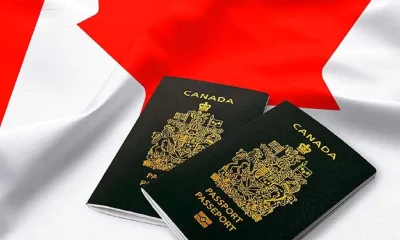Career
Hairstylist/Barber Vacancies in the USA: Career and How to Apply
Hairstylists play a crucial role in the U.S. beauty industry. They offer services that help people look and feel their best. Thus, hairstylists are always in demand across salons, spas, and independent businesses. However, the profession is not only about styling hair but also about building client relationships, understanding trends, and ensuring customer satisfaction. Skilled hairstylists contribute to the U.S.’s booming beauty sector, which generates billions of dollars.
For immigrants considering a career in hairstyling, the role involves working with diverse clients, using professional-grade tools, and keeping up with evolving techniques. This career is also intriguing because many hairstylists offer mobile or freelance services. This adds another dimension of income and exclusivity. Some accomplished ones even specialize in specific areas, such as color treatments, hair extensions, or textured hair styling.
Requirements for Hairstylists
A formal college degree is not required to become a hairstylist in the U.S., but licensing is mandatory in most states. To obtain a license, applicants typically complete a state-approved cosmetology program and pass both written and practical exams. Many salons look for candidates with a strong portfolio, creativity, and excellent customer service skills. In addition, hairstylists must stay updated on industry trends, safety standards, and new techniques.
Attention to detail, precision, and a good sense of style are key to success in this profession. Many hairstylists build clientele through social media, networking, or word-of-mouth referrals. Advanced skills like hair coloring, bridal styling, or chemical treatments can also increase job opportunities and earnings.
Visa Options for Hairstyling Jobs
Finding visa sponsorship for hairstyling jobs in the U.S. can be challenging, as most roles are considered non-specialized labor. However, a few visa pathways exist for immigrants in the beauty industry:
- H-2B Visa – Designed for temporary non-agricultural workers, this visa may be available for hairstylists in high-demand areas or during peak seasons (such as wedding or holiday seasons).
- J-1 Visa – Some cosmetology schools and training programs offer J-1 exchange visitor visas for international students or trainees looking to gain experience in the U.S. beauty industry.
- L-1 Visa – Hairstylists working for international salon chains with locations in the U.S. may qualify for an intra-company transfer under this company transfer visa.
- EB-3 Visa – This visa is for skilled and unskilled workers, and large salon franchises experiencing labor shortages may sponsor foreign hairstylists through this program.
- Entrepreneur/Investor Visa (E-2 or EB-5) – This visa is available to those who meet investment requirements and want to open their own salon chains or franchises in the U.S.
Additionally, immigrants with family-based green card eligibility or those participating in the Diversity Visa Lottery may use these pathways to secure work authorization for hairstyling roles.
Why Work as a Hairstylist in the U.S.?
1. Feed Your Creativity and Expression
Hairstyling is a profession uniquely and best suited to people with innate creative traits. Immigrants, especially those who may not have access to direct or fine art jobs but still need to make money, can take up this career. Unlike many traditional jobs, hairstyling allows professionals to express their artistic abilities daily. From intricate braiding to precision cutting, hairstylists turn ideas into reality. Clients often rely on their hairstylists for innovative styles.
2. High Earning Potential
Entry-level hairstylists may start with modest wages, but earnings can increase significantly through tips, commissions, and premium services. Skilled professionals with wedding styling or high-end coloring expertise can earn well above the average. Many hairstylists supplement their income with retail sales, charging extra for luxury treatments or working in high-end salons. This profession pays based on actual talent level, giving the incentive to improve.
3. Flexible Work Schedules
Unlike rigid corporate jobs, hairstylists often have control over their schedules. Many salons allow their more renowned stylists to choose their work hours. And entry-level ones also pick shifts. This makes it easier to balance personal commitments. Self-employed hairstylists or mobile stylists have even greater freedom in setting their appointments. This flexibility is especially beneficial for immigrants managing family responsibilities or personal endeavors.
4. Pathway to Entrepreneurship
Hairstylists have numerous career advancement options, from salon management to business ownership. Some professionals transition into celebrity hairstyling, product development, or teaching at cosmetology schools. Many hairstylists with ample experience often open their own salons and develop signature hair products. There is also always a high demand for private stylists in the fashion and entertainment industries. The beauty industry rewards ambition and skill.
5. High Demand in Diverse Communities
The demand for hairstylists remains very strong across different communities. However, skilled stylists are always in demand among diverse ethnic groups requiring specialized hair care. Immigrants with expertise in textured hair, braiding, or multicultural styles can also tap into niche markets. Cities with large immigrant populations often have dedicated salons catering to specific cultural hair needs. The opportunities and vacancies are almost limitless.
Salary Expectations for Hairstylists
Hairstylists in the U.S. earn between $25,000 and $60,000 per year. This depends on experience, location, and specialization. In high-end salons or metropolitan areas, hairstylists can earn over $100,000 annually with tips and commissions.
Hourly wages typically range from $12 to $30, with luxury salon stylists making more. Many hairstylists boost their earnings by offering premium services, working with bridal parties, or selling hair care products. Those who become salon owners or celebrity stylists can command significantly higher incomes.
Common Challenges as a Hairstylist in the U.S.
Applying for any hairstyling/salon job in the U.S. presents some challenges. This is especially true for immigrants who must navigate work visa requirements, licensing processes, and competition. However, understanding these challenges can help applicants prepare effectively.
Rigorous Cosmetology Licensing Requirements
Unlike many low-entry jobs, hairstyling requires a state-issued cosmetology license. This process can take months and involves training hours, exams, and fees. Immigrants with prior hairstyling experience may still need to complete U.S. licensing. This is because foreign certifications are rarely accepted. Some states have reciprocity agreements, but others require full retraining. In any case, the barrier to entry is higher than in other service industries.
Visa Sponsorship Limitations
Many hairstylist roles are classified as non-specialized labor, making employer sponsorship difficult. While some high-end salons may sponsor skilled professionals, visa options remain limited. The H-2B visa is an option for temporary work, but the annual admittance cap makes competition fierce. Immigrants may have better chances by applying in states or communities with a high demand for diverse hair services.
Building a Client Base
New hairstylists often struggle to establish a loyal customer base, especially in competitive areas. Unlike salaried jobs, hairstylists rely heavily on repeat clients and referrals. Immigrants who lack a local network may find it difficult to attract customers initially. This can change over time with experience and expertise. However, with long hours on their feet, handling tools, and performing repetitive movements, this might feel initially unrewarding to stylists.
Dealing with Difficult Clients
Every stylist will tell you that not all clients are easy to work with. Some may be demanding, rude, or dissatisfied with their results, leading to conflicts. Hairstylists must navigate complaints professionally while maintaining customer satisfaction. Negative reviews or word-of-mouth criticism can impact business. There is a need to strike a balance in dealing with less than optimal client experiences.
Income Fluctuations
Hairstylists often rely on commissions and tips, leading to inconsistent earnings. This is very different from salaried employees, who invariably receive stipends at the end of the month. Business can be slower during off-peak seasons, affecting financial stability. Independent stylists must also manage their own expenses, such as renting a salon chair or purchasing supplies. Bootstrapping is a common scenario many hairstylists have to face in their careers.
How To Apply
A key step is to search and apply for these hairstyling jobs on reputable job platforms. Many salon chains specify visa sponsorship in their job postings, making it easier to filter for suitable roles. One way to improve your chances is to target/network with successful salon proprietors or stylists for job openings. Large chains like Supercuts, Great Clips, Ulta Beauty, and Regis Corporation also frequently hire hairstylists and may offer training programs. Immigrants skilled in braiding, textured hair styling, or color specialization can also market their services through social media.















